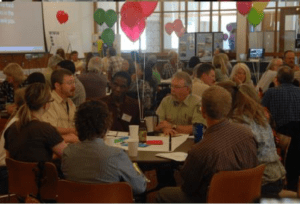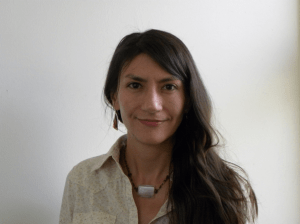By Ch’aska Huayhuaca for EDRBlog.org
 Collaboration is an important tool for addressing increasingly complex environmental problems, such as those that are widespread or cross boundaries; that are prone to conflict or involve a lot of uncertainty; or which are just too expensive or difficult to tackle alone. Collaborative processes linking diverse kinds of stakeholders may lead to long-term arrangements with new rules and procedures, often taking on characteristics of organizations (referred to here as collaboratives). As the variety of problems requiring collaboration has increased, the forms and functions of collaboratives have exploded, leading to a lot of interest in exploring these different arrangements.
Collaboration is an important tool for addressing increasingly complex environmental problems, such as those that are widespread or cross boundaries; that are prone to conflict or involve a lot of uncertainty; or which are just too expensive or difficult to tackle alone. Collaborative processes linking diverse kinds of stakeholders may lead to long-term arrangements with new rules and procedures, often taking on characteristics of organizations (referred to here as collaboratives). As the variety of problems requiring collaboration has increased, the forms and functions of collaboratives have exploded, leading to a lot of interest in exploring these different arrangements.
With the Atlas of Collaborative Conservation, a project for Colorado State University’s Center for Collaborative Conservation (CCC), we asked the following question: What does the landscape of collaboration look like in the state of Colorado, in terms of the number and location of collaboratives, the problems they address, and their formation, strategies and membership? Answering this question improved the CCC’s ability to serve collaboratives working on diverse natural resource issues in its own backyard, and contributed new insights about environmental collaboration to a broader audience. The CCC released a report in January describing our big picture findings. For example, between the mid-to-late 1970s and 2015, no fewer than 183 collaborative initiatives formed in Colorado with at least 157 still active as of 2018. They address issues including the health of forest, riparian, and rangeland ecosystems, water quantity and water quality, land use, and fish and wildlife conservation.
Get notified when new articles are posted to the EDR blog – sign up for our email list »
My PhD research builds on the data I collected for the Atlas, focusing on the ways that collaboratives emerge and take shape, and how formation affects their membership and purpose. One particular aspect focuses on the degree to which stakeholders have shared interests in the problem at the outset of collaboration, and two groups emerge, namely 1) collectively-oriented collaboratives, and 2) competitively-oriented collaboratives. To distinguish between the two, collectively-oriented collaboratives (while not necessarily free of conflict) come together to meet the shared needs and achieve mutually beneficial results; whereas competitively-oriented collaboratives are those whose participants enter collaboration with competing or conflicting interests and needs. For this group type, a partial aim of collaboration is to resolve differences in values or perceptions of the problem, or to negotiate tradeoffs between stakeholders.
There are several striking differences between these two types of groups. For example, collectively-oriented collaboratives in Colorado were more likely to be started by leaders from non-governmental organizations, members of the community, or from local government than by upper-level government representatives. Not surprisingly, collaboratives driven by shared risks or crises tended to start off with collective orientation. Collectivism was also common when collaboratives were driven by government or non-government incentives, perhaps because collaborators need to work together to generate a shared agreement stating their purpose and strategy in a short timeframe. Collectively-oriented groups often tackled issues involving pollution or safety and health, which makes sense—everyone benefits from joint actions that reduce vulnerability or increase public safety. They tended to have fewer kinds of members and smaller membership in general, and often focused their strategies on activities like monitoring and implementing restoration projects to address localized environmental problems.
On the other hand, competitively-oriented collaboratives were more commonly driven by regulatory threats or concerns, or sometimes outright mandates. They often worked on issues involving land management impacts and land conversion, property rights, livelihoods and economic wellbeing. For issues like these, gains for one set of stakeholders can mean losses for another, so stakeholders come to the table to protect their interests. They can be particularly contentious when they are tied up with cultural identity and economic survival. Collaboratives that started off with competing orientation tended to have more kinds of members represented (and larger numbers of members in general), and frequently worked together on policy-level activities to address large-scale natural resource problems.
So why does this matter? EDR professionals may already know the answer to this question better than I do! But I’ll bet many would agree that transaction costs of collaboration are important considerations. Competing stakeholder interests increase the diversity of perspectives present, which can present challenges to collective action. For example, more opinions at the table can potentially decrease trust, shared motivation, and shared commitment. The group may need to work through lengthy processes of trust-building, debate, and negotiation. These processes can be expensive in terms of the structures and arrangements necessary to guide engagement, as well as the investment of time and money. This underscores the value of conducting situation assessments to systematically think about how different issues and local context may shape participation and stakeholder interests. Collaboration is commonly advocated and promoted, and it may be tempting to take a model of collaboration from one context and apply it elsewhere. Situation assessments that consider linkages between social and environmental issues, stakeholder interests, and the purpose of collaboration could lead to improvements in designing flexible arrangements that are good fit for local conditions and for the people who volunteer their time as collaborators, and will improve their chances for long-term success.
Research insights like these have fed into the Education and Practice programs of the CCC, generating content for courses, trainings, and case studies, as well as many new partnerships over the years (including internships, fellowships, and storytelling opportunities). While the Atlas project has now wrapped up, publications about the original research that grew out of are forthcoming, and the knowledge we gained continues to inform the CCC’s efforts focused at larger geographic scales.
 Ch’aska Huayhuaca is an associate and former program coordinator of the Center for Collaborative Conservation at Colorado State University, and will receive her PhD from the Graduate Degree Program in Ecology in August of 2019.
Ch’aska Huayhuaca is an associate and former program coordinator of the Center for Collaborative Conservation at Colorado State University, and will receive her PhD from the Graduate Degree Program in Ecology in August of 2019.
